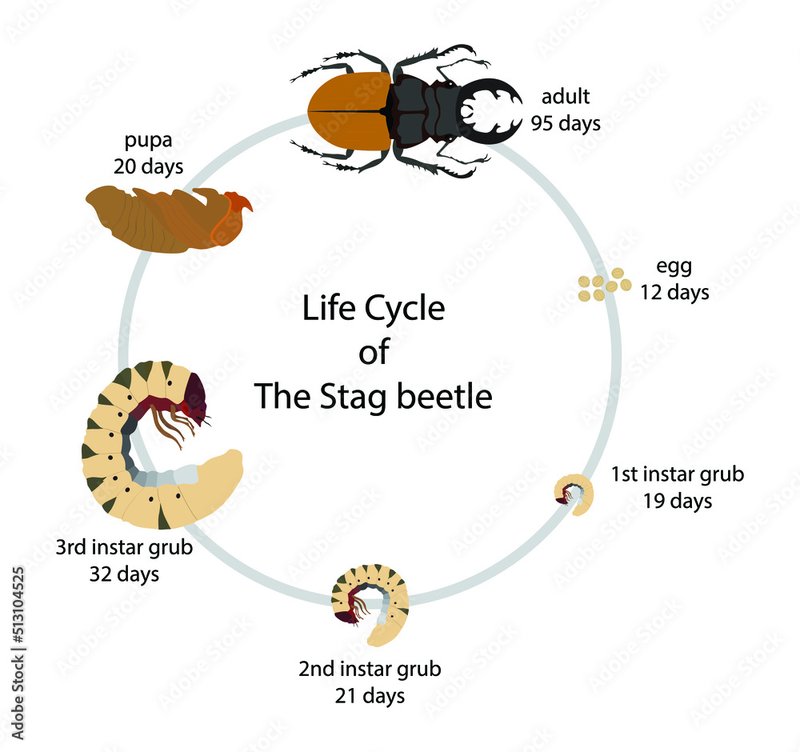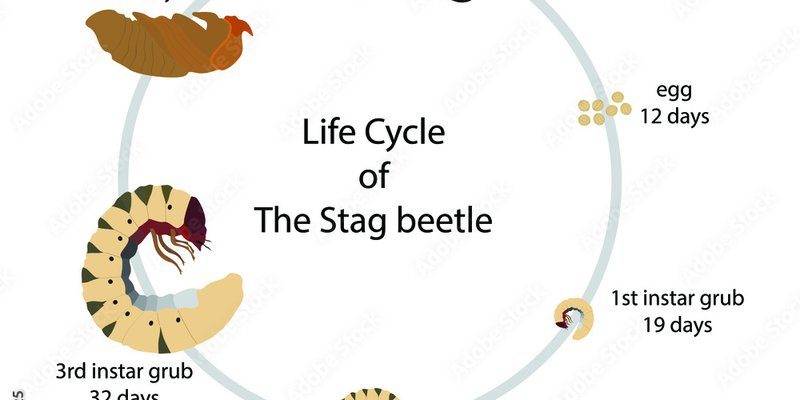
These beetles belong to the Lucanidae family and are best known for the males’ large, antler-like jaws. They’re not just pretty faces; their life cycle is a remarkable journey that many may not think about. We’ll explore each stage, helping you understand how they grow and adapt in their environment. By the end, you might find yourself viewing these charming critters with a newfound appreciation!
1. The Beginning: Egg Stage
The lifecycle of a stag beetle starts with a tiny egg. Here’s the thing: when a female stag beetle is ready to lay her eggs, she carefully chooses a moist, rotten wood or decaying material. This is super important because the larvae, once they hatch, will need that decaying matter to feed on. Each female can lay around 20 to 30 eggs, so you can imagine a small patch of rotting wood becoming a bustling nursery!
These eggs are tiny and typically white or cream-colored. They are usually laid in clusters, tucked away in the bark or crevices of wood. As they sit there, the delicate eggs start to develop, hidden from predators. After about two to three weeks, something magical happens: the eggs hatch, and small larvae emerge!
2. Growing Up: The Larval Stage
Once the larvae, often referred to as grubs, hatch from their eggs, they enter a critical phase of their lifecycle. This stage can last from several months to a few years, depending on the species and environmental conditions. Larvae are quite different from the adult beetles. They’re typically long, soft-bodied, and white, resembling little worms. But don’t let their appearance fool you; they’re quite the eaters!
Grubs spend most of their time munching on the decaying wood around them. This diet is crucial; it provides them with the nutrients they need to grow strong. While they’re busy eating, they’re also growing rapidly, shedding their skins multiple times—a process known as molting. Each time they molt, they get a little bigger, preparing for their next transformation.
You might be wondering why this stage takes so long compared to others. The truth is, it’s about building a strong foundation. The grubs are gathering energy and nutrients that will help them during their transition into adulthood.
3. The Pupal Stage
After their larval phase, stag beetles enter the pupal stage, which is akin to a teenage phase in humans—a time of significant change. Once the larvae have stored enough energy, they dig deeper into the wood and form a protective casing around themselves, called a pupa. This stage lasts anywhere from a few weeks to a few months.
During this time, the larvae undergo amazing transformations. They start to develop their adult features, such as wings, legs, and, of course, those impressive mandibles. It’s like a superhero going through their training phase, getting ready to unleash their true powers.
Inside the pupal casing, the stag beetle is quite busy. Body structures are being reformed, and cells are reorganizing into the beetle we recognize. It’s fascinating to think about how much work goes on behind the scenes, all while the pupa remains hidden away.
4. Emergence: The Adult Stage
Finally, the wait is over! After completing the pupal stage, the adult stag beetle emerges, usually in late spring or early summer. At this point, it’s important to note that not all stag beetles look the same. Males, with their characteristic large jaws, use them to compete for territory and attract mates, while females have smaller mandibles.
When they first emerge, these beetles may look a bit crumpled and dull, but don’t worry; they will soon inflate their bodies and develop their shiny, captivating colors. An adult stag beetle can live for several years, especially if conditions are favorable. They often spend their time searching for food, which mainly consists of tree sap and other sugary substances.
You might also notice them engaging in battles, using their jaws to push each other around. This is part of their courtship rituals, showcasing their strength and ensuring the fittest survive to reproduce.
5. The Role of Stag Beetles in the Ecosystem
Stag beetles play a vital role in their ecosystems. As larvae, they help recycle decaying wood and contribute to nutrient cycling in the soil. Their feeding habits aid in breaking down organic matter, making it easier for other organisms to thrive.
As adults, they become important food sources for various predators, including birds and larger insects. They also help in pollination when they feed on tree sap. You could say that stag beetles are like tiny environmental superheroes, contributing in many ways to the health of their surroundings.
Understanding how their lifecycle operates can help us appreciate the diversity of life around us. It also highlights the importance of protecting their habitats, as many stag beetle populations face threats from habitat loss and climate change.
6. Fascinating Facts About Stag Beetles
Stag beetles are full of interesting quirks. Here are some fun facts you might enjoy:
- Size Variety: Stag beetles can vary significantly in size, with some species being as small as half an inch and others growing up to four inches long!
- Mandible Size: The size of a male’s mandibles can be an indicator of his health. Bigger doesn’t always mean better, but it does play a role in mating success.
- Short Adult Lifespan: While the larval stage can last for years, adult stag beetles only live about one to three years, so they must make the most of their time.
- Symbol of Luck: In some cultures, stag beetles are considered symbols of good luck, often finding their way into art and folklore.
The lifecycle of a stag beetle is a remarkable journey filled with growth, transformation, and many challenges. From the tiny eggs laid in rotting wood to the impressive adults with their strong jaws, each stage plays a critical role in ensuring the continuation of their species. Understanding these stages can deepen our appreciation for nature and the interconnectedness of all living beings.
So, the next time you spot a stag beetle, take a moment to think about everything it has been through to get there. It’s not just another bug; it’s a little warrior with a fascinating life story worth celebrating!

